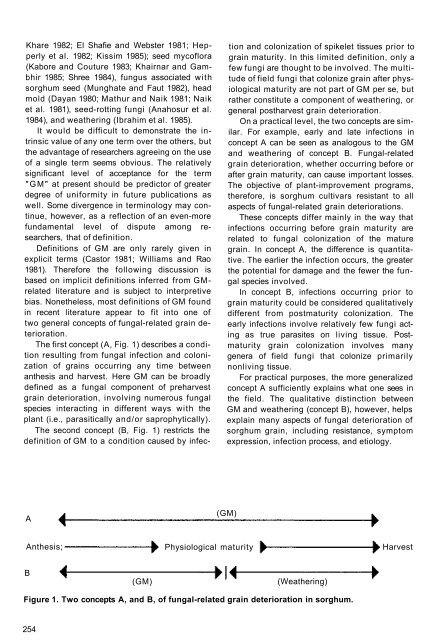Sorghum Diseases in India
Sorghum Diseases in India
Sorghum Diseases in India
Create successful ePaper yourself
Turn your PDF publications into a flip-book with our unique Google optimized e-Paper software.
Khare 1982; El Shafie and Webster 1981; Hepperly<br />
et al. 1982; Kissim 1985); seed mycoflora<br />
(Kabore and Couture 1983; Khairnar and Gambhir<br />
1985; Shree 1984), fungus associated with<br />
sorghum seed (Munghate and Faut 1982), head<br />
mold (Dayan 1980; Mathur and Naik 1981; Naik<br />
et al. 1981), seed-rott<strong>in</strong>g fungi (Anahosur et al.<br />
1984), and weather<strong>in</strong>g (Ibrahim et al. 1985).<br />
It would be difficult to demonstrate the <strong>in</strong>tr<strong>in</strong>sic<br />
value of any one term over the others, but<br />
the advantage of researchers agree<strong>in</strong>g on the use<br />
of a s<strong>in</strong>gle term seems obvious. The relatively<br />
significant level of acceptance for the term<br />
"GM" at present should be predictor of greater<br />
degree of uniformity <strong>in</strong> future publications as<br />
well. Some divergence <strong>in</strong> term<strong>in</strong>ology may cont<strong>in</strong>ue,<br />
however, as a reflection of an even-more<br />
fundamental level of dispute among researchers,<br />
that of def<strong>in</strong>ition.<br />
Def<strong>in</strong>itions of GM are only rarely given <strong>in</strong><br />
explicit terms (Castor 1981; Williams and Rao<br />
1981). Therefore the follow<strong>in</strong>g discussion is<br />
based on implicit def<strong>in</strong>itions <strong>in</strong>ferred from GMrelated<br />
literature and is subject to <strong>in</strong>terpretive<br />
bias. Nonetheless, most def<strong>in</strong>itions of GM found<br />
<strong>in</strong> recent literature appear to fit <strong>in</strong>to one of<br />
two general concepts of fungal-related gra<strong>in</strong> deterioration.<br />
The first concept (A, Fig. 1) describes a condition<br />
result<strong>in</strong>g from fungal <strong>in</strong>fection and colonization<br />
of gra<strong>in</strong>s occurr<strong>in</strong>g any time between<br />
anthesis and harvest. Here GM can be broadly<br />
def<strong>in</strong>ed as a fungal component of preharvest<br />
gra<strong>in</strong> deterioration, <strong>in</strong>volv<strong>in</strong>g numerous fungal<br />
species <strong>in</strong>teract<strong>in</strong>g <strong>in</strong> different ways with the<br />
plant (i.e., parasitically and/or saprophytically).<br />
The second concept (B, Fig. 1) restricts the<br />
def<strong>in</strong>ition of GM to a condition caused by <strong>in</strong>fec<br />
A<br />
Anthesis;<br />
B<br />
tion and colonization of spikelet tissues prior to<br />
gra<strong>in</strong> maturity. In this limited def<strong>in</strong>ition, only a<br />
few fungi are thought to be <strong>in</strong>volved. The multitude<br />
of field fungi that colonize gra<strong>in</strong> after physiological<br />
maturity are not part of GM per se, but<br />
rather constitute a component of weather<strong>in</strong>g, or<br />
general postharvest gra<strong>in</strong> deterioration.<br />
On a practical level, the two concepts are similar.<br />
For example, early and late <strong>in</strong>fections <strong>in</strong><br />
concept A can be seen as analogous to the GM<br />
and weather<strong>in</strong>g of concept B. Fungal-related<br />
gra<strong>in</strong> deterioration, whether occurr<strong>in</strong>g before or<br />
after gra<strong>in</strong> maturity, can cause important losses.<br />
The objective of plant-improvement programs,<br />
therefore, is sorghum cultivars resistant to all<br />
aspects of fungal-related gra<strong>in</strong> deteriorations.<br />
These concepts differ ma<strong>in</strong>ly <strong>in</strong> the way that<br />
<strong>in</strong>fections occurr<strong>in</strong>g before gra<strong>in</strong> maturity are<br />
related to fungal colonization of the mature<br />
gra<strong>in</strong>. In concept A, the difference is quantitative.<br />
The earlier the <strong>in</strong>fection occurs, the greater<br />
the potential for damage and the fewer the fungal<br />
species <strong>in</strong>volved.<br />
In concept B, <strong>in</strong>fections occurr<strong>in</strong>g prior to<br />
gra<strong>in</strong> maturity could be considered qualitatively<br />
different from postmaturity colonization. The<br />
early <strong>in</strong>fections <strong>in</strong>volve relatively few fungi act<strong>in</strong>g<br />
as true parasites on liv<strong>in</strong>g tissue. Postmaturity<br />
gra<strong>in</strong> colonization <strong>in</strong>volves many<br />
genera of field fungi that colonize primarily<br />
nonliv<strong>in</strong>g tissue.<br />
For practical purposes, the more generalized<br />
concept A sufficiently expla<strong>in</strong>s what one sees <strong>in</strong><br />
the field. The qualitative dist<strong>in</strong>ction between<br />
GM and weather<strong>in</strong>g (concept B), however, helps<br />
expla<strong>in</strong> many aspects of fungal deterioration of<br />
sorghum gra<strong>in</strong>, <strong>in</strong>clud<strong>in</strong>g resistance, symptom<br />
expression, <strong>in</strong>fection process, and etiology.<br />
Figure 1. Two concepts A, and B, of fungal-related gra<strong>in</strong> deterioration <strong>in</strong> sorghum.<br />
254<br />
(GM)<br />
Physiological maturity<br />
(GM) (Weather<strong>in</strong>g)<br />
Harvest








